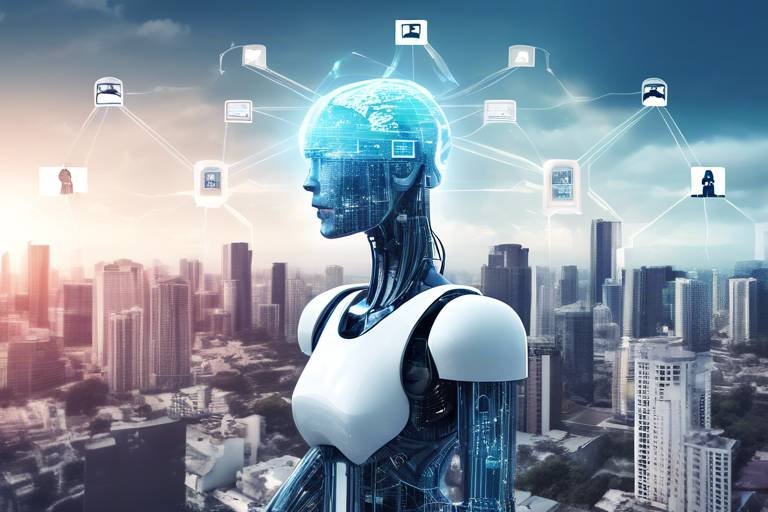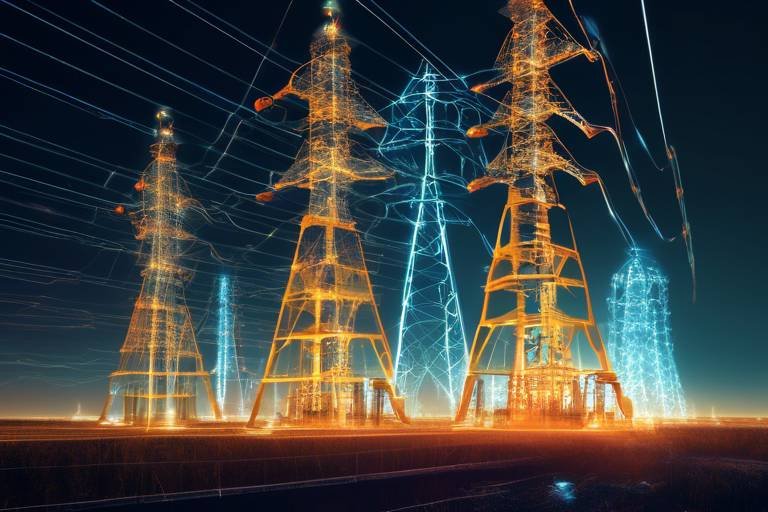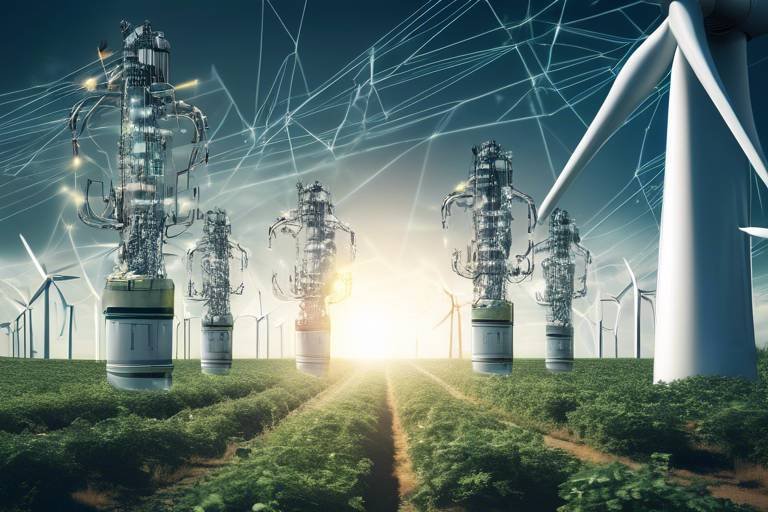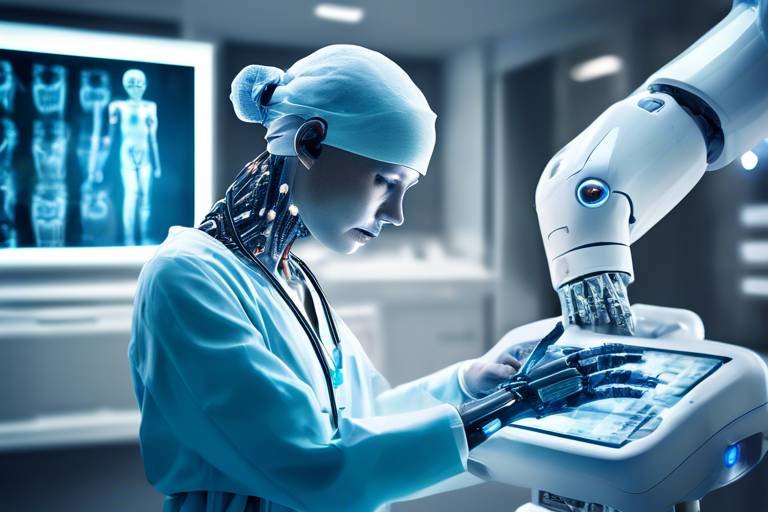Artificial Intelligence in Mining: Future Prospects
Artificial Intelligence (AI) is not just a buzzword; it’s a game changer in the mining industry. Imagine a world where machines can predict failures before they happen, optimize operations in real-time, and enhance safety in some of the most dangerous work environments on Earth. The integration of AI into mining operations is paving the way for a more efficient, safer, and sustainable future. As we dive deeper into the transformative role of AI, we'll uncover how it’s reshaping the mining landscape and what the future holds for this critical industry.
AI is revolutionizing the mining sector by improving efficiency, safety, and decision-making processes. From autonomous trucks that transport materials to AI-driven analytics that optimize resource extraction, the applications are vast. For instance, AI algorithms can analyze geological data to identify the best locations for drilling, significantly reducing the time and costs associated with exploration. Moreover, machine learning models can predict equipment failures, enabling proactive maintenance and minimizing downtime. The future of mining is not just about extracting resources; it's about doing so intelligently and responsibly.
The benefits of integrating AI into mining operations are numerous and impactful. Companies that adopt AI technologies can expect:
- Cost Reduction: By optimizing processes and reducing downtime, AI can significantly lower operational costs.
- Improved Productivity: Automated systems and predictive analytics allow for more efficient workflows and greater output.
- Enhanced Safety Measures: AI can monitor hazardous conditions and provide real-time alerts to workers, reducing the risk of accidents.
These advantages not only improve the bottom line for mining companies but also contribute to a safer and more sustainable industry.
One of the most exciting applications of AI in mining is predictive maintenance. This technology uses AI algorithms to analyze data from equipment sensors, enabling companies to anticipate failures before they occur. Imagine a scenario where a mining truck can alert operators about a potential mechanical issue days in advance. This proactive approach not only reduces maintenance costs but also significantly minimizes downtime, allowing for smoother operations.
Data analytics is at the heart of predictive maintenance. By utilizing advanced analytics, mining companies can monitor equipment performance in real-time. This capability allows for timely interventions and optimizes operational efficiency. For example, if a piece of equipment shows signs of wear and tear, operators can schedule maintenance before a complete breakdown occurs. This not only saves money but also enhances the overall productivity of mining operations.
Several mining companies have already embraced predictive maintenance with remarkable success. For instance, a major mining firm implemented an AI-driven predictive maintenance system and reported a 30% reduction in equipment downtime. This case study exemplifies the tangible benefits of AI, demonstrating how predictive analytics can lead to significant improvements in operational efficiency.
Safety is paramount in the mining industry, and AI technologies are playing a crucial role in enhancing safety protocols. By minimizing human error and providing advanced monitoring systems, AI can help create a safer working environment. For example, AI-powered drones can be used to survey hazardous areas, reducing the need for human workers to enter potentially dangerous zones. Additionally, AI systems can analyze data from various sources to predict unsafe conditions, allowing for timely interventions.
Despite the numerous benefits, the adoption of AI in mining is not without challenges. High implementation costs, data privacy concerns, and the need for skilled personnel are significant hurdles that companies must overcome. Understanding these obstacles is crucial for a successful transition to AI-driven operations.
Implementing AI technologies often requires a substantial initial investment, which can be a significant barrier for many mining companies. However, it's essential to consider the long-term benefits and potential return on investment. By improving efficiency and reducing costs, AI can provide significant value over time, making the initial investment worthwhile.
The shift towards AI-driven operations necessitates a skilled workforce capable of managing new technologies. Training and workforce adaptation are critical to embracing AI advancements in mining. Companies must invest in upskilling their employees to ensure they can effectively work alongside AI systems, fostering a culture of innovation and adaptability.
Looking ahead, the future of AI in mining appears promising. With ongoing advancements in technology and increasing adoption rates, we can expect to see even more innovative applications of AI in the industry. From autonomous vehicles to sophisticated data analytics tools, the potential for growth is immense. As mining companies continue to embrace AI, they will not only enhance their operational efficiency but also contribute to a more sustainable future for the industry.
- What are the main benefits of AI in mining?
AI improves efficiency, reduces costs, enhances safety, and increases productivity. - How does predictive maintenance work?
Predictive maintenance uses AI to analyze data from equipment sensors to foresee potential failures. - What challenges do mining companies face when adopting AI?
High initial investment, data privacy concerns, and the need for a skilled workforce are significant challenges. - What is the future of AI in mining?
The future looks bright, with ongoing technological advancements and increased adoption leading to innovative applications.

The Role of AI in Modern Mining
Artificial intelligence is not just a buzzword; it's a revolutionary force transforming the mining industry in ways we could only dream of a few years ago. Imagine a world where machines can predict equipment failures, analyze vast amounts of data in real-time, and even assist in making critical decisions that can save lives and resources. That's the reality we're stepping into today. AI is reshaping mining processes by enhancing efficiency, safety, and decision-making, making it a vital component of modern operations.
One of the most exciting applications of AI in mining is autonomous vehicles. These self-driving trucks and drones can transport materials from one location to another without human intervention, significantly reducing the risk of accidents and improving productivity. By utilizing advanced sensors and machine learning algorithms, these vehicles can navigate through complex terrains, making them invaluable assets in remote mining sites.
Another key area where AI shines is in data analysis. Mining generates an enormous amount of data, from geological surveys to equipment performance metrics. AI algorithms can process this data at lightning speed, uncovering patterns and insights that humans might miss. For instance, predictive analytics can forecast the best times to extract minerals, optimizing resource allocation and minimizing waste. This not only boosts profits but also promotes sustainable mining practices.
AI also plays a crucial role in safety monitoring. By deploying AI-powered surveillance systems, mining companies can keep a close eye on their operations, identifying potential hazards before they escalate into dangerous situations. For example, AI can analyze video feeds from cameras placed throughout a mining site to detect unsafe behaviors or environmental risks. This proactive approach to safety is essential in an industry known for its hazardous working conditions.
Furthermore, AI can enhance the decision-making process in mining operations. With the ability to analyze data from various sources, AI systems can provide managers with actionable insights, enabling them to make informed decisions quickly. This agility is critical in an industry where conditions can change rapidly, and timely decisions can mean the difference between profit and loss.
In summary, the role of AI in modern mining is multifaceted and transformative. From autonomous vehicles and advanced data analytics to enhanced safety measures and improved decision-making, AI is paving the way for a more efficient, safer, and sustainable mining industry. As technology continues to evolve, we can expect even more innovative applications of AI that will further revolutionize how we extract and manage resources.
- What is AI's main contribution to mining? AI enhances efficiency, safety, and decision-making through advanced data analysis, autonomous vehicles, and predictive maintenance.
- How does AI improve safety in mining? AI systems monitor operations in real-time, identifying potential hazards and unsafe behaviors, which helps in preventing accidents.
- Are there any challenges in adopting AI in mining? Yes, challenges include high initial investment costs, data privacy concerns, and the need for a skilled workforce to manage new technologies.
- What is predictive maintenance in mining? Predictive maintenance uses AI to anticipate equipment failures before they occur, reducing downtime and maintenance costs.

Benefits of AI Integration
The integration of artificial intelligence (AI) in mining operations is not just a trend; it’s a game changer that brings a plethora of benefits. Imagine a world where mining companies can operate with enhanced precision, lower costs, and improved safety. Sounds futuristic, right? But this is the reality that AI is creating in the mining sector. By leveraging advanced algorithms and data analytics, mining companies are discovering new ways to optimize their operations and increase their bottom line.
One of the most significant advantages of AI integration is cost reduction. Traditional mining operations often involve high labor costs and inefficient processes. With AI, companies can automate routine tasks, which reduces the need for manual labor and minimizes human error. For instance, AI-driven machinery can perform tasks such as drilling and excavation with remarkable accuracy, leading to less wasted material and lower operational costs. Moreover, AI can analyze vast amounts of data to identify the most cost-effective mining methods, allowing companies to allocate resources more efficiently.
Another key benefit is improved productivity. AI technologies can process and analyze data at lightning speed, providing real-time insights that help mining companies make informed decisions quickly. This rapid data analysis allows for better planning and resource allocation, which in turn enhances productivity. For example, AI can predict the best times for equipment maintenance, ensuring that machines are always running at peak performance. This proactive approach not only saves time but also maximizes output.
Furthermore, AI plays a crucial role in enhanced safety measures. Mining can be a hazardous occupation, with risks ranging from equipment malfunctions to environmental hazards. AI technologies, such as machine learning and computer vision, can monitor conditions in real-time and alert workers to potential dangers. For instance, AI systems can analyze data from sensors to detect abnormalities in equipment performance, allowing for immediate intervention. This capability significantly reduces the risk of accidents and injuries in the workplace.
To illustrate these benefits, let’s take a look at a few key areas where AI is making a significant impact:
- Predictive Maintenance: AI algorithms can predict when equipment is likely to fail, enabling timely maintenance that prevents costly downtimes.
- Data-Driven Decision Making: By analyzing historical data, AI can help companies make more informed decisions regarding resource allocation and operational strategies.
- Environmental Monitoring: AI can assist in monitoring environmental impacts, ensuring compliance with regulations and promoting sustainable mining practices.
As we can see, the benefits of AI integration in mining are profound and multifaceted. Companies that embrace these technologies not only improve their operational efficiency but also position themselves as leaders in an increasingly competitive industry. The future of mining is undoubtedly intertwined with the advancements in AI, paving the way for smarter, safer, and more sustainable practices.

Predictive Maintenance
Predictive maintenance is a game-changer in the mining industry, leveraging the power of artificial intelligence to foresee potential equipment failures before they disrupt operations. Imagine a mining site where machinery operates seamlessly, without the dreaded downtime that can cost companies millions. With AI-driven predictive maintenance, this vision is becoming a reality. By analyzing historical data and real-time performance metrics, AI algorithms can identify patterns that indicate when a piece of equipment is likely to fail. This proactive approach not only minimizes unexpected breakdowns but also extends the lifespan of machinery, leading to significant cost savings over time.
The essence of predictive maintenance lies in its ability to transform data into actionable insights. Mining companies can monitor various parameters such as vibration, temperature, and operational cycles. By utilizing data analytics, they can create a comprehensive picture of equipment health. For instance, if a conveyor belt shows unusual vibration patterns, the AI system can alert maintenance teams to investigate before a complete failure occurs. This shift from reactive to proactive maintenance is akin to having a crystal ball that reveals the future of machinery performance.
To illustrate the impact of predictive maintenance, consider the following table showcasing the benefits realized by mining companies that have integrated AI technologies into their maintenance strategies:
| Company | Before AI Implementation | After AI Implementation | Improvement (%) |
|---|---|---|---|
| Mining Corp A | 15% downtime | 5% downtime | 66.67% |
| Miner B | $500,000 maintenance costs | $300,000 maintenance costs | 40% |
| Excavators Inc. | 20% equipment failure | 10% equipment failure | 50% |
As seen in the table, the integration of predictive maintenance not only reduces downtime but also significantly cuts maintenance costs. The results speak for themselves, showcasing the tangible benefits that can be achieved through AI technologies.
In addition to financial gains, predictive maintenance also fosters a culture of safety within mining operations. By ensuring that equipment is functioning optimally, the risks associated with machinery failures are substantially lowered. This is particularly crucial in the mining sector, where hazardous conditions can lead to severe accidents. Therefore, investing in predictive maintenance is not just a smart business decision; it's a commitment to the safety and well-being of all personnel on-site.
In conclusion, predictive maintenance powered by AI is revolutionizing how mining companies manage their equipment. By anticipating failures and optimizing maintenance schedules, companies can operate more efficiently and safely, ultimately leading to a more sustainable mining industry. As technology continues to evolve, we can expect even more innovative solutions to emerge, further enhancing the role of AI in predictive maintenance.

Data Analytics for Equipment Monitoring
In the mining industry, where equipment is often subjected to harsh conditions, data analytics plays a pivotal role in ensuring optimal performance and longevity. By leveraging advanced analytics, mining companies can monitor their equipment in real-time, providing critical insights that drive operational efficiency. Imagine having a crystal ball that predicts when your machinery might fail; this is the power of data analytics in action. It allows operators to make informed decisions, reducing the risk of unexpected breakdowns and costly downtime.
The integration of IoT sensors into mining equipment has revolutionized how data is collected and analyzed. These sensors continuously gather data on various parameters such as temperature, vibration, and load conditions. This data is then transmitted to centralized systems where sophisticated algorithms analyze it, identifying patterns and anomalies that could indicate potential issues. For instance, if a conveyor belt shows signs of excessive vibration, the system can alert maintenance teams to investigate before a failure occurs. This proactive approach not only saves money but also enhances safety by preventing hazardous situations.
Furthermore, the insights derived from data analytics empower mining companies to optimize their maintenance schedules. Instead of relying on a fixed maintenance timetable, which can lead to unnecessary downtime or missed issues, companies can adopt a more dynamic approach. By analyzing historical data and current performance metrics, they can implement a predictive maintenance strategy that aligns with the actual condition of their equipment. This shift from reactive to proactive maintenance is a game-changer in the industry, significantly enhancing both productivity and safety.
To illustrate the impact of data analytics on equipment monitoring, consider the following table that highlights key benefits and metrics observed by companies that have adopted these technologies:
| Benefit | Metric |
|---|---|
| Reduced Downtime | Up to 30% decrease |
| Cost Savings | Annual savings of $500,000 on maintenance |
| Increased Equipment Lifespan | Average extension of 15% |
| Improved Safety | Reduction in accidents by 25% |
In conclusion, the role of data analytics in equipment monitoring is not just about collecting numbers; it's about transforming those numbers into actionable insights. As mining companies continue to embrace these technologies, they position themselves not only to enhance their operational efficiency but also to create a safer working environment for their employees. In a world where every second counts, the ability to monitor and respond to equipment performance in real-time is invaluable.
- What is data analytics in mining? Data analytics in mining refers to the use of advanced algorithms and technologies to analyze data collected from mining equipment to improve performance and safety.
- How does predictive maintenance work? Predictive maintenance uses data analytics to predict when equipment is likely to fail, allowing for timely maintenance that prevents unexpected breakdowns.
- What are the benefits of using IoT in mining? IoT enhances equipment monitoring by providing real-time data, which leads to improved efficiency, safety, and cost savings.

Case Studies of Successful Implementation
When it comes to the integration of artificial intelligence in mining, real-world examples speak volumes about its transformative power. One standout case is that of Rio Tinto, a global mining giant that has embraced AI to enhance operational efficiency. By utilizing AI-driven predictive maintenance systems, Rio Tinto has successfully reduced equipment failures by an impressive 30%. This not only minimizes downtime but also significantly lowers maintenance costs, creating a ripple effect of savings throughout their operations.
Another compelling example is BHP Billiton, which has implemented AI technologies to optimize its supply chain management. By analyzing vast amounts of data, BHP has improved its logistics operations, leading to a 15% increase in shipment efficiency. This case illustrates how AI can streamline processes that are often bogged down by human error and inefficiencies.
In a different context, Anglo American has used AI to enhance safety measures in its mines. By deploying AI-powered monitoring systems, they have been able to detect hazardous conditions in real-time, effectively reducing workplace accidents by 20%. This not only protects the workforce but also fosters a culture of safety that is vital in such a perilous industry.
These examples highlight the tangible benefits of AI in mining, showcasing how companies can leverage technology to not only improve their bottom line but also enhance safety and operational efficiency. The integration of AI is not just a trend; it's becoming a crucial component of modern mining practices.
- What is predictive maintenance in mining?
Predictive maintenance refers to the use of AI and data analytics to anticipate equipment failures before they occur, allowing companies to perform maintenance only when necessary.
- How does AI improve safety in mining?
AI enhances safety by providing real-time monitoring systems that can detect hazardous conditions, helping to minimize human error and prevent accidents.
- What are the main challenges of adopting AI in mining?
The primary challenges include high initial investment costs, data privacy concerns, and the need for a skilled workforce to manage new technologies.
- Can small mining companies benefit from AI?
Absolutely! While the initial investment may be daunting, AI can help small companies improve efficiency and reduce costs, ultimately leading to better profitability.

Enhanced Safety Measures
In the mining industry, safety has always been a paramount concern. The nature of the work, often conducted in hazardous environments, poses significant risks to workers. However, with the advent of artificial intelligence (AI), the landscape of safety in mining is undergoing a remarkable transformation. AI technologies are not just enhancing efficiency; they are also fundamentally changing how safety protocols are implemented and monitored.
One of the most exciting aspects of AI in mining is its ability to minimize human error, which is often the leading cause of accidents in the field. By deploying AI-driven systems, mining companies can utilize advanced algorithms to analyze vast amounts of data from various sources, including equipment sensors, environmental monitors, and even worker behavior. This data-driven approach allows for real-time assessments of safety conditions, leading to proactive measures that can prevent accidents before they happen.
For instance, AI can be integrated into wearable technology that monitors vital signs and fatigue levels of miners. These devices can alert supervisors if a worker is showing signs of distress or is at risk of fatigue, enabling timely interventions. Imagine a scenario where a worker's heart rate spikes or their movement patterns indicate exhaustion; the AI system can immediately send an alert, ensuring that the worker receives the necessary rest or medical attention. This not only protects the individual but also enhances overall team safety.
Moreover, AI-powered drones and autonomous vehicles are revolutionizing the way inspections are conducted in mining sites. Drones equipped with high-resolution cameras and sensors can survey hazardous areas that are difficult or unsafe for human workers to access. This technology allows for comprehensive site assessments without putting personnel at risk. The data collected can be analyzed to identify potential hazards, such as unstable ground or equipment malfunctions, allowing for swift corrective action.
Additionally, AI systems can improve communication and coordination among teams. In emergency situations, AI can facilitate real-time communication, ensuring that all personnel are informed about potential dangers and the best course of action. This capability is crucial in reducing response times during critical incidents, which can be the difference between a minor issue and a major disaster.
As we look toward the future, the integration of AI in mining safety protocols is likely to expand even further. Companies that embrace these technologies will not only enhance their operational efficiency but also foster a culture of safety that prioritizes the well-being of their workforce. In the long run, investing in AI for safety measures can lead to lower accident rates, reduced insurance costs, and improved employee morale, ultimately contributing to a more sustainable mining operation.
To summarize, the enhanced safety measures brought about by AI in mining are nothing short of revolutionary. By leveraging data analytics, wearable technology, drones, and autonomous systems, mining companies are paving the way for a safer working environment. The future of mining safety is bright, and AI is at the forefront of this transformation.
- How does AI improve safety in mining?
AI enhances safety by analyzing data from various sources to predict and prevent accidents, monitor worker health, and automate inspections. - What role do wearable technologies play in mining safety?
Wearable technologies monitor miners' vital signs and fatigue levels, allowing for real-time alerts and interventions to prevent accidents. - Can drones be used for safety inspections in mining?
Yes, drones can safely survey hazardous areas, collect data, and identify potential risks without putting human workers at risk. - What are the long-term benefits of implementing AI for safety?
Long-term benefits include reduced accident rates, lower insurance costs, improved employee morale, and a stronger safety culture within the organization.

Challenges in AI Adoption
While the potential of artificial intelligence in the mining industry is enormous, the path to its adoption is not without hurdles. Many mining companies are eager to integrate AI technologies, yet they often find themselves grappling with significant challenges that can hinder progress. One of the primary obstacles is the high initial investment required to implement AI solutions. This encompasses not only the cost of the technology itself but also the expenses associated with training personnel and upgrading existing systems. For many organizations, especially smaller operations, this upfront cost can feel like a mountain to climb.
In addition to financial constraints, there are also data privacy concerns that can complicate the adoption of AI. As mining companies collect vast amounts of data from various sources, they must ensure that this information is handled securely and complies with regulations. The fear of potential data breaches or misuse can lead to hesitance in fully embracing AI solutions. Furthermore, the need for skilled personnel to manage and operate these advanced technologies cannot be overstated. The mining industry has traditionally relied on a workforce skilled in manual operations, and the shift towards AI-driven processes may require significant retraining and upskilling of employees.
To tackle these challenges effectively, mining companies can consider several strategies. For instance, establishing partnerships with technology providers can help mitigate initial costs by sharing resources and expertise. Additionally, investing in training programs that focus on AI literacy can empower the existing workforce, making the transition smoother and more efficient. In this rapidly evolving landscape, companies that embrace a culture of continuous learning and adaptation will be better positioned to leverage the benefits of AI.
Moreover, the industry can benefit from government support and incentives aimed at encouraging the adoption of innovative technologies. By fostering an environment that prioritizes technological advancement, stakeholders can help alleviate some of the financial burdens associated with AI integration. Ultimately, while the challenges are real, they are not insurmountable. With the right approach and resources, the mining industry can successfully navigate the complexities of AI adoption, paving the way for a more efficient and safe future.
- What are the main challenges of AI adoption in mining?
The main challenges include high initial investment, data privacy concerns, and the need for skilled personnel. - How can mining companies overcome the financial barriers to AI?
Companies can consider partnerships with technology providers, seek government support, and explore financing options to ease the financial burden. - Why is workforce training important for AI implementation?
As mining operations shift towards AI-driven processes, a skilled workforce is essential to manage and operate these new technologies effectively. - What role does data security play in AI adoption?
Data privacy and security are critical as companies must protect vast amounts of sensitive information from breaches and comply with regulations.

High Initial Investment
The journey towards integrating artificial intelligence in mining operations is not without its hurdles, and one of the most significant challenges is the required for AI technologies. Mining companies often find themselves at a crossroads, weighing the potential benefits of AI against the substantial costs involved in its adoption. These costs can include everything from purchasing cutting-edge software and hardware to the expenses associated with training personnel and restructuring existing workflows.
To put this into perspective, consider that the initial setup for AI systems can range widely depending on the scale of operations and the specific technologies being implemented. For instance, a small mining operation may face costs upwards of $100,000 for basic AI tools, while larger enterprises could see expenses soar into the millions. This disparity can create a daunting barrier, especially for smaller companies that may lack the financial resources to make such a leap.
Moreover, the return on investment (ROI) for AI in mining isn't always immediately evident. Companies must navigate through a period of adaptation where the benefits of AI, such as increased efficiency and reduced downtime, may take time to manifest. To illustrate this, we can look at a simple table comparing initial costs against potential long-term savings:
| Investment Type | Estimated Initial Cost | Potential Long-Term Savings |
|---|---|---|
| AI Software | $50,000 - $500,000 | Up to 30% reduction in operational costs |
| Hardware Upgrades | $20,000 - $200,000 | Decreased maintenance costs and improved efficiency |
| Training Programs | $10,000 - $100,000 | Enhanced workforce productivity |
As the table shows, while the initial investment can be substantial, the potential long-term savings and productivity gains can justify the costs. However, companies must carefully consider their financial strategies and possibly seek external funding or partnerships to mitigate the burden of these upfront expenses.
Ultimately, the decision to invest in AI technologies is a balancing act between immediate financial constraints and the long-term vision of operational excellence. Mining companies that can navigate this challenge successfully will not only enhance their competitiveness but also pave the way for a more innovative and efficient industry.
- What is the average cost of implementing AI in mining? The costs can vary significantly, ranging from $100,000 for small operations to millions for larger enterprises.
- How long does it take to see ROI from AI investments? ROI can take time to materialize, often requiring a few years of adaptation and optimization.
- Are there financing options available for AI investments? Yes, many companies explore partnerships, grants, and loans to help manage the initial costs of AI integration.

Workforce Adaptation
As the mining industry embraces the wave of artificial intelligence (AI), the significance of cannot be overstated. Transitioning to AI-driven operations is akin to teaching an old dog new tricks; it requires patience, understanding, and a willingness to learn. The mining workforce must evolve alongside these technologies to ensure that the integration is seamless and beneficial. This means that companies need to invest not only in technology but also in the people who will be operating it.
One of the primary challenges in this adaptation process is the skills gap. Many workers may not possess the necessary technological expertise to operate advanced AI systems effectively. This situation calls for a robust training program aimed at upskilling employees. Companies can implement various training methods, such as:
- On-the-job training: Allowing employees to learn while they work can enhance their understanding of new technologies in a practical setting.
- Workshops and seminars: These can be organized to provide insights into AI applications and their benefits.
- Online courses and certifications: Encouraging employees to pursue online learning can help them gain relevant skills at their own pace.
Moreover, fostering a culture of continuous learning is essential. As AI technologies evolve, so too must the skills of the workforce. Encouraging employees to stay updated with the latest advancements will not only enhance their individual capabilities but also contribute to the overall efficiency of the mining operations. Companies can create mentorship programs where experienced workers guide newer employees, ensuring that knowledge is shared and retained within the organization.
Additionally, the transition to AI may lead to concerns about job security among workers. It's crucial for mining companies to communicate transparently about how AI will augment rather than replace human roles. By emphasizing that AI is a tool designed to enhance productivity and safety, companies can alleviate fears and foster a collaborative environment where humans and machines work together seamlessly.
To summarize, workforce adaptation in the face of AI integration is not merely about training; it's about creating a supportive ecosystem that values learning, embraces change, and recognizes the importance of human input in a technology-driven future. By investing in their workforce and addressing the challenges head-on, mining companies can position themselves at the forefront of industry innovation, ready to tackle the challenges of tomorrow.
Q1: What skills are essential for workers in an AI-driven mining environment?
A1: Essential skills include data analysis, familiarity with AI software, problem-solving abilities, and a willingness to learn new technologies. Training programs can help workers develop these skills.
Q2: Will AI replace human jobs in mining?
A2: While AI will automate certain tasks, it is designed to enhance human roles, not replace them. Workers will be needed to manage, operate, and maintain AI systems.
Q3: How can mining companies support their workforce during this transition?
A3: Companies can offer training programs, create a culture of continuous learning, and communicate openly about the benefits of AI to ease concerns about job security.

The Future of AI in Mining
The future of artificial intelligence (AI) in mining is not just bright; it's practically blazing! As we stand on the brink of a technological revolution, the mining industry is poised to undergo a transformation that could redefine how we extract resources from the Earth. Imagine a world where autonomous vehicles navigate treacherous terrains, drones survey vast landscapes, and AI algorithms analyze geological data in real-time to pinpoint the most lucrative sites for excavation. Sounds like science fiction? Well, it’s closer to reality than you might think!
One of the most exciting prospects is the development of autonomous mining operations. With advancements in machine learning and robotics, companies are beginning to deploy autonomous trucks and drilling equipment. These machines can operate around the clock, significantly increasing productivity while minimizing human risk in hazardous environments. The ability to work 24/7 without fatigue is a game-changer, allowing for a more efficient extraction process.
Moreover, the integration of AI-driven data analytics will continue to evolve. In the near future, mining companies will harness vast amounts of data collected from various sources, including sensors on equipment, geological surveys, and market trends. By utilizing advanced AI algorithms, they can make informed decisions that optimize operations, reduce waste, and enhance profitability. This data-driven approach will not only streamline processes but also lead to more sustainable mining practices.
As we look ahead, the role of AI in predictive analytics will expand. This technology will evolve to provide even more accurate forecasts regarding equipment maintenance and operational efficiency. Imagine a scenario where AI can predict not only when a machine will fail but also suggest the best time to perform maintenance based on operational demands and external factors like weather conditions. Such capabilities will minimize downtime and maximize output, ensuring that mining operations run smoothly.
However, the future isn't just about machines and algorithms. Human expertise will remain critical in this AI-driven landscape. As AI takes over more routine tasks, the workforce will need to adapt and evolve. This means that training programs will be essential to equip workers with the skills necessary to manage and collaborate with AI technologies. The mining industry will need to invest in its people, creating a workforce that is not only tech-savvy but also capable of leveraging AI tools to their fullest potential.
In addition, the ethical implications of AI in mining will come to the forefront. As companies collect and analyze more data, issues surrounding data privacy and security will need to be addressed. Mining companies must ensure that they comply with regulations while also maintaining the trust of their stakeholders. Transparency will be key in navigating these challenges, and companies that prioritize ethical AI use will likely gain a competitive edge.
Finally, the exploration of sustainable practices will become increasingly intertwined with AI technologies. The mining industry faces immense pressure to reduce its environmental footprint, and AI can play a pivotal role in achieving this goal. From optimizing energy consumption to reducing waste, AI-driven solutions will help mining companies operate more sustainably, aligning with global efforts to combat climate change.
In conclusion, the future of AI in mining is not just about technological advancements; it’s about creating a holistic approach that combines innovation with sustainability and ethics. As we move forward, we can expect a mining industry that is not only more efficient and productive but also more responsible and responsive to the needs of our planet.
- What are the main benefits of AI in mining? AI enhances efficiency, reduces costs, improves safety, and supports predictive maintenance.
- How does AI improve safety in mining operations? AI minimizes human error and provides advanced monitoring systems to detect hazards.
- What challenges does the mining industry face in adopting AI? High initial investment, data privacy concerns, and the need for skilled personnel are significant challenges.
- Will AI replace human workers in mining? While AI will automate routine tasks, human expertise will still be essential for managing and collaborating with AI technologies.
Frequently Asked Questions
- What is the role of AI in modern mining?
AI plays a transformative role in modern mining by enhancing efficiency, safety, and decision-making processes. It helps automate tasks, optimize operations, and improve overall productivity, making mining safer and more efficient.
- What are the benefits of integrating AI into mining operations?
Integrating AI into mining operations offers numerous advantages, including cost reduction, improved productivity, and enhanced safety measures. Companies can expect lower operational costs and increased efficiency, leading to better profits and safer work environments.
- How does predictive maintenance work in mining?
Predictive maintenance utilizes AI technologies to anticipate equipment failures before they occur. By analyzing data from equipment performance, mining companies can schedule maintenance proactively, reducing downtime and maintenance costs significantly.
- Can you give examples of successful AI implementation in mining?
Absolutely! Many mining companies have successfully implemented AI solutions, leading to significant improvements in operational efficiency. For instance, some have adopted AI-driven predictive maintenance systems that have dramatically reduced equipment failure rates and maintenance expenses.
- How does AI enhance safety in mining operations?
AI enhances safety by minimizing human error and providing advanced monitoring systems. For example, AI can analyze real-time data to identify hazardous conditions and alert workers, thereby preventing accidents and ensuring a safer working environment.
- What challenges do mining companies face in adopting AI?
Mining companies face several challenges when adopting AI, including high initial investment costs, data privacy concerns, and the need for a skilled workforce. Overcoming these obstacles requires strategic planning and investment in training and technology.
- Why is the initial investment in AI considered high?
The initial investment for AI technologies can be significant due to the costs associated with software, hardware, and training. However, many companies find that the long-term savings and efficiency gains justify the upfront expenses.
- How important is workforce training in AI adoption?
Workforce training is crucial for AI adoption in mining. As operations become more technology-driven, having a skilled workforce that can manage and leverage AI technologies is essential for maximizing the benefits of AI integration.
- What does the future hold for AI in the mining industry?
The future of AI in mining looks bright, with continuous advancements in technology and increasing adoption rates. We can expect more innovative applications of AI that will further revolutionize mining operations and enhance productivity and safety.



















